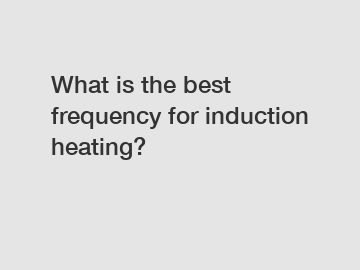What is the best frequency for induction heating?
What is the best frequency for induction heating? .
Induction heating, a technology widely used in many industrial applications, relies on electromagnetic induction to generate heat in conductive materials. It employs an alternating magnetic field to induce eddy currents within the material, which in turn produces heat due to resistance. However, one key factor that determines the efficiency and effectiveness of induction heating is the frequency at which the alternating current is applied. In this article, we will explore the various frequencies used in induction heating and discuss their advantages and disadvantages.
Frequency plays a crucial role in induction heating, as it directly affects the depth of penetration and the heating rate of the material. Here are some key points to consider:

1. High Frequency (above 10 kHz):
- High-frequency induction heating, typically ranging from 100 kHz to 1 MHz, offers excellent heating efficiency and precise control.
- Due to its higher frequency, this method is suitable for smaller components and surface hardening applications where shallow heat penetration is required.
- It provides rapid heating rates, which can lead to shorter processing times and increased productivity.
- The equipment required for high-frequency induction heating is generally more expensive due to higher power requirements and specialized components.
2. Medium Frequency (1 kHz to 10 kHz):
- Medium-frequency induction heating, commonly between 1 kHz and 10 kHz, strikes a balance between efficiency and depth of penetration.
- It provides deeper heat penetration compared to high-frequency heating, making it suitable for parts with larger cross-sections or thicker materials.
- Medium-frequency induction heating is widely used for various applications such as hardening, tempering, brazing, and melting.
- The equipment cost is generally lower compared to high-frequency heating, making it a popular choice for many industries.
3. Low Frequency (below 1 kHz):
- Low-frequency induction heating, typically in the range of a few hundred Hz, offers deep heat penetration with slower heating rates.
- This method is often preferred for bulk heating, where the entire volume of the material needs to be uniformly heated.
- It is commonly used for applications such as heat treatment of large gear wheels, billets, and forgings.
- Low-frequency heating requires larger and more robust equipment, making it suitable for heavy-duty applications but less cost-efficient for smaller components.
4. Frequency Considerations:
- The choice of frequency depends on the specific application requirements, material properties, and desired heating characteristics.
- Higher frequencies offer better control and efficiency for smaller components, while lower frequencies are more suitable for larger or bulk heating applications.
- It is important to consider the electrical and thermal properties of the material being heated, as they affect the depth of penetration and heating uniformity.
- The equipment's power requirements and cost should also be taken into account when selecting the appropriate frequency.
In conclusion, the best frequency for induction heating depends on various factors such as the size of the components, desired heating depth, and material properties. High-frequency heating offers precise control and efficient heating for smaller components, while medium-frequency strikes a balance between efficiency and penetration depth. Low-frequency heating provides deep heat penetration but at a slower heating rate. Selecting the optimal frequency ensures efficient and effective induction heating, leading to improved productivity and quality in industrial processes. So, what is the best frequency for induction heating? Well, the answer lies in understanding the specific requirements and characteristics of the application at hand.
For more information, please visit OEM screw rod high frequency quenching supplier, OEM Chain Induction Hardening Equipment company, induction shrink fitting.
198
0
0

Comments
All Comments (0)